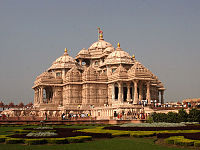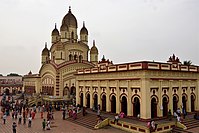Temple

A temple (from the
Religions whose places of worship are generally not called "temples" in English include
The form and function of temples are thus very variable, though they are often considered by believers to be, in some sense, the "house" of one or more deities. Typically, offerings of some sort are made to the deity, and other rituals are enacted, and a special group of clergy maintain and operate the temple. The degree to which the whole population of believers can access the building varies significantly; often parts, or even the whole main building, can only be accessed by the clergy. Temples typically have a main building and a larger precinct, which may contain many other buildings or may be a dome-shaped structure, much like an igloo.
The word comes from Ancient Rome, where a templum constituted a sacred precinct as defined by a priest, or augur.[1] It has the same root as the word "template", a plan in preparation for the building that was marked out on the ground by the augur.
Hindu temples
Hindu temples are known by many different names, varying on region and language, including Alayam,
The basic elements of the Hindu temple remain the same across all periods and styles. The most essential feature is the inner sanctuary, the garbhagriha or womb-chamber, where the primary murti or cult image of a deity is housed in a simple bare cell. Around this chamber there are often other structures and buildings, in the largest cases covering several acres. On the exterior, the garbhagriha is crowned by a tower-like shikhara, also called the vimana in the south. The shrine building may include an ambulatory for parikrama (circumambulation), one or more mandapas or congregation halls, and sometimes an antarala antechamber and porch between garbhagriha and mandapa.
A Hindu temple is a symbolic house, the seat and dwelling of
Outside of the Indian subcontinent (
-
The Golden temple of Mahalakshmi, Vellore, Tamil Nadu, India
-
Famous Guruvayur Temple, a Traditional Hindu Temple in Kerala, India.
-
A view of the Maa Naina Devi Temple, Mallital, Nainital, Uttarakhand, India
-
Greater Kolkata, West Bengal, India
Buddhist temples
Buddhist temples include the structures called
Temples in
Three types of structures are associated with the
, also called chaitya grihas), which later came to be called temples in some places. The pagoda is an evolution of the Indian stupas.The initial function of a stupa was the veneration and safe-guarding of the relics of
In accordance with changes in religious practice, stupas were gradually incorporated into chaitya-grihas (prayer halls). These are exemplified by the complexes of the Ajanta Caves and the Ellora Caves (Maharashtra). The Mahabodhi Temple at Bodh Gaya in Bihar is another well-known example.
As Buddhism spread, Buddhist architecture diverged in style, reflecting the similar trends in Buddhist art. Building form was also influenced to some extent by the different forms of Buddhism in the northern countries, practising Mahayana Buddhism in the main and in the south where Theravada Buddhism prevailed.
Jain temples

A Jain temple, called a
Sikh temples
A Sikh temple is called a gurdwara, literally the "doorway to the Guru". Its most essential element is the presence of the Guru, Guru Granth Sahib. The gurdwara has an entrance from all sides, signifying that they are open to all without any distinction whatsoever. The gurdwara has a Darbar Sahib where the Guru Granth Sahib is seen and a Langar where people can eat free food.[7] A gurdwara may also have a library, nursery, and classroom.[8]
Mesopotamian temples

The temple-building tradition of
Egyptian temples
Ancient Egyptian temples were meant as places for the deities to reside on earth. Indeed, the term the Egyptians most commonly used to describe the temple building, ḥwt-nṯr, means 'mansion (or enclosure) of a god'.[9]
A god's presence in the temple linked the human and divine realms and allowed humans to interact with the god through ritual. These rituals, it was believed, sustained the god and allowed it to continue to play its proper role in nature. They were, therefore, a key part of the maintenance of maat, the ideal order of nature and of human society in Egyptian belief.[10] Maintaining maat was the entire purpose of Egyptian religion,[11] and thus it was the purpose of a temple as well.[12]
Ancient Egyptian temples were also of economic significance to Egyptian society. The temples stored and redistributed grain and came to own large portions of the nation's arable land (some estimate as much as 33% by the New Kingdom period).[13] In addition, many of these Egyptian temples utilized the Tripartite Floor Plan in order to draw visitors to the center room.
Greco-Roman temples
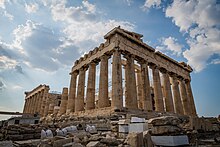
Greek and Roman temples were originally built out of wood and mud bricks, but as the empires expanded, the temples grew to monumental size, made out of materials such as stone and marble on raised platforms. While the color has long since faded, The columns would have been painted in white, blue, red, and black. Above the columns would have been a sculpted or painted depiction of a myth or battle, with freestanding sculptures in the pediment triangles. The roofs were tiled and had sculptures of mythical animals or deities on the tops or corners. Greek temples also had several standard floor plans with very distinct column placement.[14]
Located in the front of the temple were altars intended for sacrifices or offerings.
Greco-Roman temples were built facing eastward, utilizing the rising sun in morning rituals. The location each temple was built also depended on many factors such as environment, myth, function, and divine experience. Most were built on sites associated with myths or a place a god had been believed to have performed a feat, or founded a town or city. Many Roman temples had close associations with important events in Roman history, such as military victories. Temples in cities were often dedicated to the founding deity of the city, but also served as civic and social centers. The Temple of Saturn even held the state treasury and treasury offices in its basement.[14]
European polytheistic temples
The Romans usually referred to a holy place of a
Zoroastrian temples
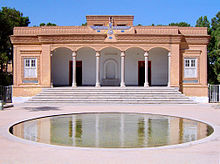
A
In the Zoroastrian religion, fire (Atar), together with clean water (Aban), are agents of ritual purity. Clean, white "ash for the purification ceremonies is regarded as the basis of ritual life," which, "are essentially the rites proper to the tending of a domestic fire, for the temple fire is that of the hearth fire raised to a new solemnity".[This quote needs a citation]
Chinese temples
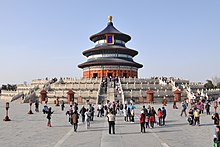
Chinese temples refer to temples in accordance with
Other than the base constructed from an elevated platform of earth and stones, most parts of Chinese temples are made of timber carpentry, with parts of brick masonry and glazed ceramics for roofs and tile decorations. Typical Chinese temples have curved overhanging eaves and complicated carpentry of stacked roof construction. Chinese temples are known for their vivid colour and rich decorations. Their roofs are often decorated with mythical beasts, such as Chinese dragons and qilins, and sometimes also Chinese deities. Chinese temples can be found throughout Mainland China and Taiwan, and also where Chinese expatriate communities have settled abroad; thus Chinese temples can be found in Chinatowns worldwide.
Indonesian temples

According to local beliefs, the Java valley had thousands of Hindu temples that co-existed with Buddhist temples, most of which were buried in the massive eruption of Mount Merapi in 1006 AD.
Mesoamerican temples

Temples of the
Some classic Mesoamerican pyramids are adorned with stories about the feathered serpent
.Jewish synagogues and temples
In
The
The Greek word
Since the 18th century, Jews in Western and Central Europe began to apply the name temple, borrowed from the French where it was used to denote all non-Catholic prayer houses, to synagogues. The term became strongly associated with Reform institutions, in some of which both congregants and outsiders associated it with the elimination of the prayers for the restoration of the Jerusalem Temple, though this was not the original meaning—traditional synagogues named themselves "temple" over a century before the advent of Reform, and many continued to do so after.[17] In American parlance, temple is often synonymous with synagogue, but especially non-Orthodox ones.
The term kenesa, from the Aramaic for 'assembly', is used to describe the places of worship of Karaite Jews.
Example of such temple is the
-
A model ofHerod's Temple adjacent to the Shrine of the Book exhibit at the Israel Museum, Jerusalem.
Christian temples
Orthodox Christianity

The word temple is used frequently in the tradition of
.Catholicism
The word temple has traditionally been rarely used in the English-speaking
The principal words typically used to distinguish houses of worship in Western Christian architecture are
Protestantism
Some Protestant churches use this term; above main entrance of the
in Latin which reads "this temple (...) was constructed by king Oscar II."Beginning in the late eighteenth century, following the Enlightenment, some Protestant denominations in France and elsewhere began to use the word temple to distinguish these spaces from Catholic churches. Evangelical and other Protestant churches make use of a wide variety of terms to designate their worship spaces, such as church, tabernacle or temple. Additionally some breakaway Catholic churches such as the Mariavite Church in Poland have chosen to also designate their central church building as a temple, as in the case of the Temple of Mercy and Charity in Płock.
Latter Day Saint movement
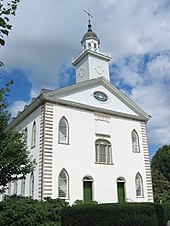
According to
The Book of Mormon, which Latter Day Saints believe is a companion book of scripture with the Bible, refers to temple building in the ancient Americas by a group of people called the Nephites. Though Book of Mormon authors are not explicit about the practices in these Nephite temples, they were patterned "after the manner of the temple of Solomon" ([20]) and served as gathering places for significant religious and political events (e.g. Mosiah 1–6; 3rd Nephi 11–26).[21]
The Church of Jesus Christ of Latter-day Saints

Other Latter Day Saint denominations
Various
- The Church of Christ (Wightite), a Latter Day Saint denomination formed by Lyman Wight following the death of Joseph Smith, built first Mormon temple west of the Mississippi in Zodiac, Texas.[25] about three miles from Fredericksburg.
- In 1990 or earlier a temple in Ozumba, Mexico was built by the Apostolic United Brethren.[26]
- On April 17, 1994, the Prophet-President Wallace B. Smith. The Community of Christ also currently owns the original Kirtland Temple, dedicated in 1836 by the Church of the Latter Day Saints (later renamed the Church of Jesus Christ of Latter Day Saints), in Kirtland, Ohio. The Community of Christ operates the Kirtland Temple as a historic site.
- In 2005YFZ Ranch Temple by the Fundamentalist Church of Jesus Christ of Latter-Day Saints Church began. It is located just outside Eldorado in Schleicher County, Texas.[28] However, as of April 2014, the State of Texas took physical and legal possession of the property.[29][30] as it was used to "commit or facilitate certain criminal conduct."[29][30]
- A pyramid-shaped temple near Modena, Utah, was built by the Righteous Branch of the Church of Jesus Christ of Latter-day Saints.[26]
Esoteric Christianity
- Esoteric Christian Temple of the Rosicrucian Fellowship with its round 12-sided building architecture set on top of a mesa and facing east, the rising Sun. This modern-day temple is ornamented with alchemical and astrologicalsymbols.

Masonic temples

Others

- pillars decorated with abstract, enigmatic pictograms and animal reliefs.
- Temples of Sheikh, ancient temples in Sheikh, Somalia
- Temple of Yeha, the oldest standing structure in Yeha, Ethiopia; built around 700 BCE
- In the Star Wars films, the Jedi Temple is located on Coruscant.
- Wolmyeongdong Natural Temple, located in South Korea, was developed beginning in 1990 and continues to this day.
- .
Convention sometimes allows the use of temple in some of the following cases:
- Baháʼí Faith temple (Mashriqu'l-Adhkárs or 'Houses of Worship').
- Shrines of the traditional miao, or ancestral hall in English. Joss house is an obsolete American term for such kind of places of worship.
- Confucian temple or Temple of Confucius.
- Aritar, Sikkim.
- jinja are normally called shrinesin English in order to distinguish them from Buddhist temples (-tera, -dera).
- daoguan(道观, literally 'place of contemplation of the Tao') in Chinese, guan being the shortened version of daoguan.
See also
- Balinese temple
- Candi of Indonesia
- Chinese pagoda
- Chinese temple
- Dravidian architecture
- Jangam
- List of temples of Tamil Nadu
- Mandi (Mandaeism)
- Mosque
- National Temple of Divine Providence
- Place of worship
References
- ^ Latin Dictionary and Grammar Aid. University of Notre Dame. 26 May 2009. Retrieved 24 July 2009.
- ISBN 978-81-7823-542-4; Page 1
- ISBN 978-81-208-0223-0., Quote: "The [Hindu] temple is the seat and dwelling of God, according to the majority of the [Indian] names" (p. 135); "The temple as Vimana, proportionately measured throughout, is the house and body of God" (p. 133).
- ^ "Hinduism - Early Hinduism (2nd century bce–4th century ce) | Britannica". www.britannica.com. Retrieved 2023-01-20.
- ^ "New York Buddhist Temple for World Peace". Kadampanewyork.org. 1997-08-01. Archived from the original on 2012-06-11. Retrieved 2012-06-20.
- ^ Babb, Lawrence, A (1996). Absent lord: ascetics and kings in a Jain ritual culture. Published University of California Press. p. 66.
{{cite book}}: CS1 maint: multiple names: authors list (link) - ^ "The Gurdwara". bbc.co.uk. BBC. Retrieved 18 March 2013.
- ^ "Gurdwara Requirements". worldgurudwaras.com. Archived from the original on 4 October 2013. Retrieved 18 March 2013.
- ^ Spencer 1984, p. 22, 44; Snape 1996, p. 9
- ^ Dunand and Zivie-Coche 2005, pp. 89–91
- ^ Assmann 2001, p. 4
- ^ Shafer, Byron E., "Temples, Priests, and Rituals: An Overview", in Shafer 1997, pp. 1–2
- ^ André Dollinger. The Ancient Egyptian Economy. pp. 5 [1] Retrieved June 19, 2012
- ^ OCLC 1243160502.
- ^ "Replika Candi Pawon". Vihāra Jakarta Dhammacakka Jaya.
- ISBN 9780500290767.
- ^ Michael A. Meyer, Response to Modernity: A History of the Reform Movement in Judaism, Wayne State University Press, 1995. p. 42.
- ^ 100-годишнина на синагогата в София, dnes.bg, September 6, 2009
- ^ Baldayac, Rafael. "Iglesia y templo: diferencia". La Informacion. Retrieved 23 January 2018.
- ^ "The Second Book of Nephi Chapter 5 - 5:16". Lds.org. 2012-02-21. Retrieved 2012-06-20.
- ^ "Temples". Achoiceland.com. 2010-10-01. Retrieved 2012-06-20.
- ^ "List of Temples". Archived from the original on 2002-02-14.
- ^ "Frequently Asked Questions". Archived from the original on 2002-02-14.
- ^ Utah Attorney General's Office and Arizona Attorney General's Office. The Primer, Helping Victims of Domestic Violence and Child Abuse in Polygamous Communities Archived 2013-01-27 at the Wayback Machine. Updated June 2006. Page 23.
- ^ Johnson, Melvin C. (2006). Polygamy on the Pedernales:Lyman Wight's Mormon Villages in Antebellum Texas, 1845-1858. Logan, Utah: Utah State University Press. p. 125. Retrieved 6 February 2015.
- ^ ISBN 1-930074-13-1
- ^ "Jeffs dedicates FLDS temple site at YFZ Ranch". The Eldorado Success. January 11, 2005. Archived from the original on March 7, 2005. Retrieved April 6, 2008.
- ^ "FLDS temple appears complete". Ben Winslow (AP). 31 January 2006.
- ^ a b "Texas Seizes Polygamist Warren Jeffs' Ranch". NBC News. Associated Press. April 17, 2014. Retrieved April 18, 2014.
- ^ a b Carlisle, Nate (April 17, 2014). "Texas takes possession of polygamous ranch". The Salt Lake Tribune. Retrieved April 17, 2014.
- ^ "9 Amazing Nepali Temple You Should Visit Before You Die". Prasant Bhatt. 2018-04-13. Archived from the original on 2018-04-14. Retrieved 2018-04-13.
Further reading
- Hani, Jean, Le symbolisme du temple chrétien, G. Trédaniel (editor); [2. éd.] edition (1978), 207 pp., ISBN 2-85707-030-6




